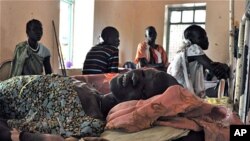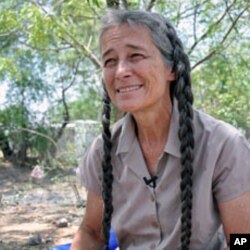In newly independent South Sudan, deadly Kala Azar disease is still raging in some of the most remote areas lacking basic health services.
Standing next to the single tent she now calls home in the scorching sunshine, Alaskan-born Dr. Jill Seaman explained how after coming to South Sudan in 1989 and visiting villages where only five out of 1,000 people had survived a Kala Azar outbreak, she could not tear herself away from this swampland.
“We walked through villages where there was still the ash left from fires, there were still sticks left to tie your cattle up, but there were no people left, you were walking through ghost villages," said Seaman. "And that, plus watching all the skeletal people walking into the clinic every night to get treated and asking them ‘how many people in your family have died?’ and hearing the answer 12, 14, 8, 13 - it kind of bonds you to a community, and I suppose that’s why I’m still here.”
That Kala Azar outbreak killed around half the population in the area, and around half the 11,000 cases reported last year were treated at the clinic in Old Fangak.
An infectious disease carried by a parasite and transmitted by the bite of a sand fly, Kala Azar causes a fever that does not subside. If left untreated, Dr. Seaman said around 95 percent of Kala Azar patients simply waste away or die after catching other infectious diseases.
Three percent of patients died in Old Fangak last year, but the clinic has already treated 1,800 people with Kala Azar this year.
In a stuffy ward packed with patients laid head to toe on narrow beds, Nyadak Mouk cuddles her five-year-old son, who is suffering from Kala Azar-induced fever.
She walked eight hours from Keew village to reach the clinic. Having lost four of her six children to disease, she said she is not leaving until the boy is cured.
Mouk said she did not bring the other children to the clinic so she does not know why they died. She has been in Old Fangak for six months and fears if she moves away from the treatment center, she will lose her young son as well.
“I don’t know what they died of as I didn’t bring them to the clinic - they died in the village. I now live near the clinic. I left home six months ago, and I can’t be away from it as without treatment he will die,” Mouk said.
Dr. Abdi Nasir, a communicable disease specialist for the United Nations World Health Organization, said Kala Azar usually comes in cycles about every 10 years.
But residents of South Sudan are particularly vulnerable to infection because of attacks from rebel groups which displace thousands of people at a time, compounded by generally poor living conditions and nutrition.
Dr. Nasir said an outbreak that began in 2009 has now affected 25,000 people and still is raging. It is the worst in 30 years.
“We very much hope the outbreak to die down and the number it goes down, but looking at the different factors and the situation, it doesn’t look that way,” said Nasir.
Dr. Nasir expects another 11,000 people will be treated this year, but the treatment doesn't come cheaply. Even at the reduced prices available to WHO, the cure costs around $600 per person, not counting the expense of transporting it to remote places such as Old Fangak.
Dr. Seaman said if the medicines keep coming, the clinic can try and deal with Kala Azar.
But she said lack of food in the area is her primary concern. Last year, the surrounding areas had almost no harvest after heavy rains flooded crops. While more than 350,000 people have come to South Sudan since it gained independence from Sudan in July, further stretching resources, the border has practically been closed, doubling the prices of staple foods.
Health workers in the clinic said malnourished people are more likely to contract the disease as their immune systems are already low, and they are less likely to recover or will relapse.
Back in the ward, patients almost skeletal from the effects of Kala Azar try to regain their strength with plain bean mash that is the only food on offer.
How many lives the disease will claim this year depends on how much food and medicine aid agencies can deliver to this neglected area before next month's rains cut the region off from the world.








